Signs of Quality: Plucking Standards by Tea Type
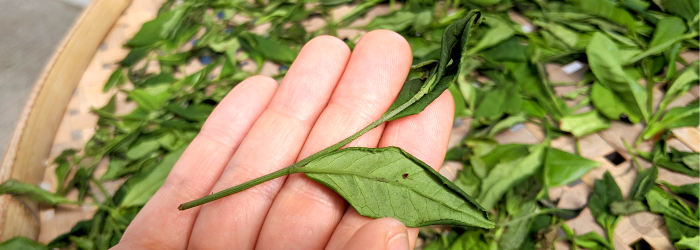
We often discuss the importance of harvest dates in determining tea quality, with an emphasis on spring harvests, especially for lightly oxidized teas. In truth, the impact of harvest date is inseparable from another signal of quality that is easier to see in the finished tea: plucking standards.
Learn more about the importance of harvest dates >>
Spring harvests are highly prized, especially in the categories of green and white teas, because they include the youngest leaf buds and earliest growth of the year. The highest quality green and white teas include only freshly sprouted buds, selected carefully by hand from bushes full of last year’s mature growth. While the early harvest date makes the quality of these teas possible, it is the selection standards imposed by talented tea pickers that ultimately shapes the natural sweetness and smooth finish of spring teas.
Not all teas, however, taste best when crafted from these youngest buds. The crafting techniques that tea-makers use to produce a tea’s final character are tailored to suit the specific plucking standards for each traditional tea. Within some categories, leaf selection is the primary factor in determining the highest grades from those made for everyday drinking. In others, plucking standards are relatively consistent, and levels of quality are determined by other factors.
Find out what we look for in any high quality tea >>
For tea consumers, learning to recognize the proper plucking standards for each tea can get complex. Each category has its own set of rules, often further complicated by different regional varieties or personal preferences. Of course, quality ultimately boils down to what tastes good, but because plucking standards often determine the available quantity of a tea, a basic understanding of what to look for can help demystify market demands and pricing.
Green Tea
Because they are minimally oxidized, the quality of any green tea depends heavily on the quality of the plucked leaf. As mentioned briefly above, the highest quality green teas consist of only the earliest spring growth, made up of small buds and leaves. These young leaves, much like baby spinach or arugula, are naturally sweeter and more tender than the mature leaves lower down on the stem. They are also very limited in quantity, appearing during a very short harvest season just once each year.
Learn more about why spring green teas are so valuable >>
The buds and top leaves of the plant are plucked throughout the spring, with later harvest dates yielding buds and leaves of increasing size. With rising temperatures and more sun exposure, the plants grow more quickly, and develop more polyphenols and methylxanthines, which taste astringent and bitter. The most abundant crops, harvested in summer, also contain the greatest quantities of these compounds.
Watch Alice explain the difference between spring and summer crops in this video:
Many styles of green tea exist on the spectrum between the two extremes, with varying balance between the natural sweetness of early spring and the bold body of later harvests. One unusual example is Liu An Gua Pian, which is grown farther north than other popular Chinese green teas. The cooler climate slows growth and prevents the development of dry, bitter flavors, so tea crafters in this region prefer to use the secondary and tertiary leaf of the spring harvest, rather than the more typical bud set. The result is notably richer than other spring green teas, without the usual sacrifice of natural sweetness.
Find out how weather and climate impact tea flavor >>
White Tea
Another minimally processed style, white teas use similar plucking standards to those used for green teas. In fact, because the process of drying and finishing white tea uses only gentle heat, and there are fewer crafting variations, the distinctions between plucking standards can be even more obvious. The highest grade of traditional white tea, named Silver Needle, uses only the closed buds of early spring growth. Later spring harvests might use a mix of buds and top leaves, as in Bai Mu Dan, or select only larger, opened leaves, as for Shou Mei.
The highest grades of white tea give the entire category its name, as the youngest buds of the Da Bai (‘Big White’) variety are coated in downy trichomes that give them a white-ish color. As with green tea, however, these early harvests are limited in quantity, and the vast majority of white teas on the market are made up of more mature leaves. While plucking standards certainly play a large part in the overall quality of white tea, the provenance of these teas carries equal importance, with the small region of Fuding County, Fujian being the most authentic and valued point of origin.
Learn why Fuding County is regarded as the home of the best white tea >>
Oolong Tea
The huge diversity of regional styles in this broadly defined category each have their own plucking standards, making it hard to generalize any guidelines about what to look for. Luckily, oolong quality usually depends more on provenance, variety, and crafting techniques - harvest dates and plucking standards are still important, but less so than in other categories.
With that said, we can make a few sweeping statements about plucking standards in this category. Generally, the more intensive processing steps used in oxidizing and roasting the teas are best applied to leaves which are a bit more mature. While new spring leaves are still valued for the depth of flavor they develop during the early period of slow growth, they are given a bit more time on the plant to mature. Plucking standards target the secondary, tertiary, and occasional additional leaves - only the greenest oolongs typically include the bud set.
Discover the four main types of oolong tea >>
Lower leaf selections can also include parts of the stem; Taiwanese oolongs often use the complete configuration of new growth, with the bud set, top leaves, and stem remaining intact during processing. The impact of the stem on quality is debatable though, and ultimately boils down to personal preference. While teas entered in competitions usually use leaves trimmed from the stem for more ‘purity’ of flavor, we enjoy the extra complexity of flavor that the included stem adds. Notably, however, the inclusion of many stems with no leaves attached can yield bitter flavor.
Black Tea
The range and variety of black tea styles also makes it hard to define a single plucking standard. In this category, the best harvest date and leaf selection depends largely on the provenance of the tea, because black teas are grown in so many distinct climates. Moreover, the worldwide popularity of black tea means that consumers have a wide variety of flavor preferences: while Chinese black tea drinkers often value a smooth finish and naturally sweet flavor, English tea drinkers prioritize a bold body that will hold up to milk and sugar.
Explore the difference between Chinese & Indian styles of black tea >>
Different leaf selections are highlighted by the effects of oxidation, though, and can help determine what to expect when purchasing. The smallest buds of the plant turn a bright golden-orange when fully oxidized, while mature leaves develop the more familiar ‘black’ color. The black teas traditionally valued in China include a high proportion of golden leaf buds, which lend natural sweetness and rich texture, just as in green and white teas. Mature-leaf black teas, which can be produced in larger quantities, were historically preferred for export, and often yield more astringency.
Learn more about the effects of terroir and different styles of black tea in this video:
No matter what the plucking standard, though, bitterness and astringency in black teas can be tempered by climate and careful craftsmanship. Black teas grown in Taiwan, for instance, with less direct sunlight than in traditional regions of southern China, develop sweeter flavors due to slower growth. In addition, industrial techniques used to harvest, oxidize, and roast black teas for the mass market can exacerbate bitterness and astringency due to rough handling or leaf breakage. Traditionally crafted teas, more gently handled, generally taste better.
Find out more about different types of black tea >>
Pu-erh Tea
With the added variables of fermentation and age, pu-erh teas are arguably the most diverse style of tea, and there is very little consensus on the ‘best’ flavor profile for a pu-erh to have. Some pu-erh drinkers prefer the dry, fresh flavor of young, unfermented pu-erh, while others seek out the bold peaty notes of rapidly fermented shou pu-erh, and still others savor the complexity of well-aged sheng pu-erh. Of course, preferences vary in plucking standards as well, both between tea crafters and between consumers.
With that caveat, the leaf selection used for each pu-erh tea can reveal something about the type of flavor to expect. As with black teas, ‘small leaf’ pu-erh teas, often called ‘Emperor’ or ‘Imperial’ teas, are made from early harvests, and generally have a richer body thanks to higher carbohydrate content. These leaves, more easily plucked from neatly trimmed hedges on cultivated tea farms, are often used to craft bold-bodied shou teas. ‘Large leaf’ teas, on the other hand, are often referred to as ‘Wild’ because they are plucked from plants allowed to grow into small trees, and yield a crisp astringency that lends itself well to sheng fermentation.
Learn the difference between the two main categories of pu-erh tea >>
Stem and twig inclusion can also be a controversial topic in pu-erh production, but ultimately boils down to personal preference again. Small leaf pu-erh teas from carefully managed farms are less likely to include stems, both because harvesting is easier to control and because the focus of the tea is on the smooth texture of the carbohydrate-rich leaves. Large leaf pu-erhs are more likely to include stems for added complexity and depth, but as with other styles, there should always be more leaf than stem visible in the finished tea.
What plucking standards do you look for in your favorite teas? Let us know what you think in the comments below!
Sign up for our newsletter to get blog updates in your inbox!



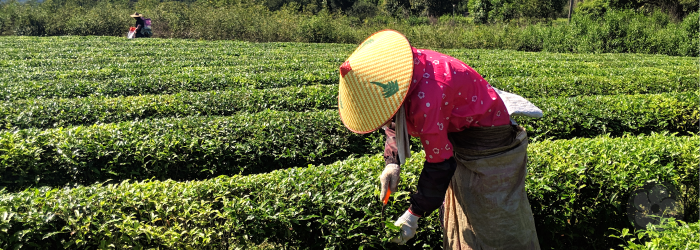

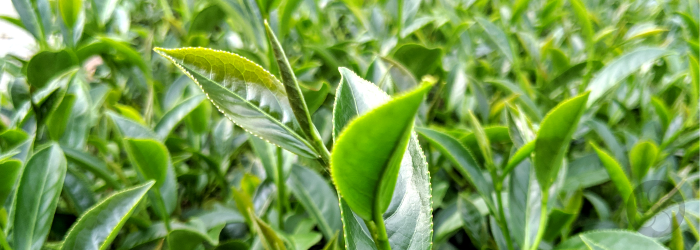
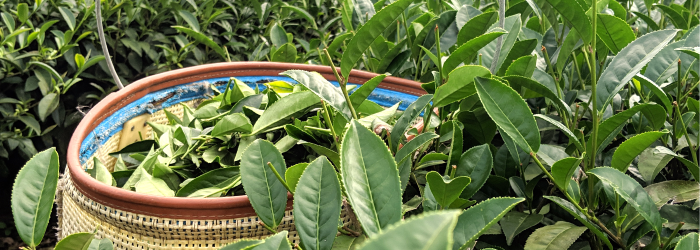
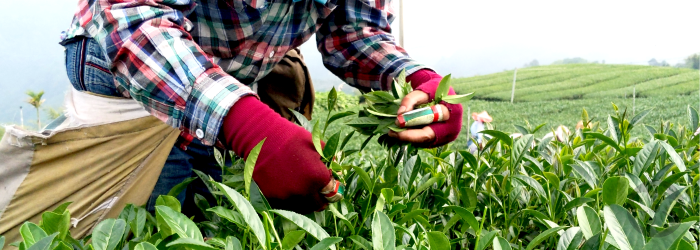

Comments on this post (0)